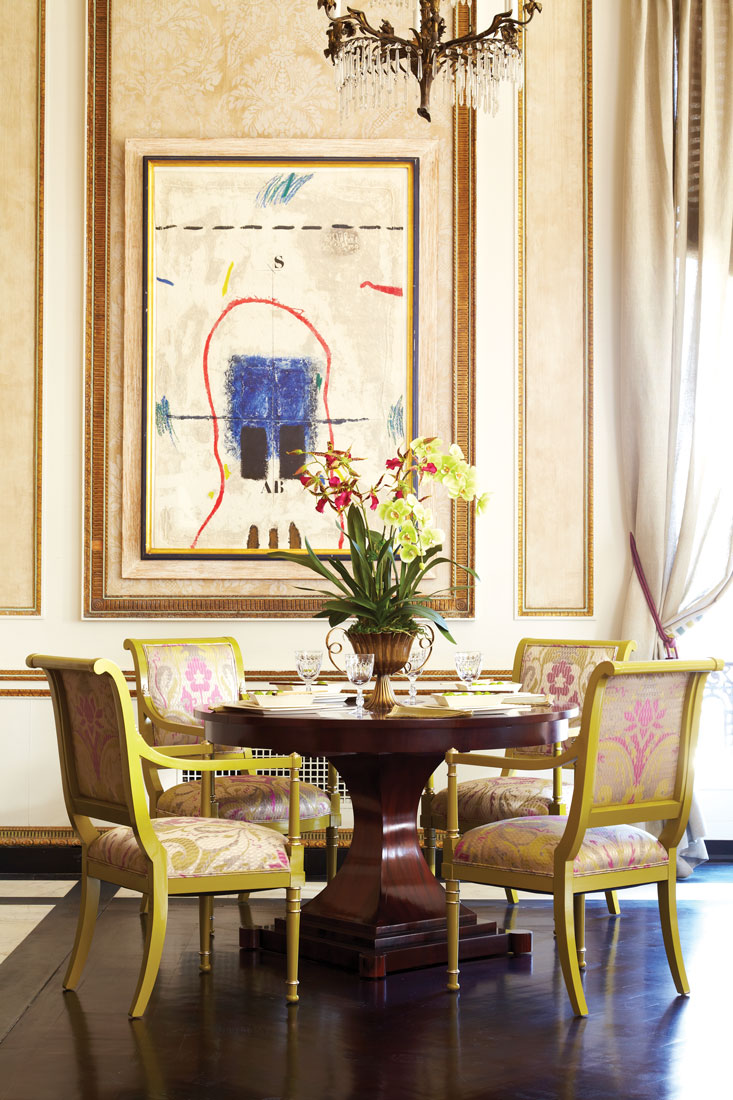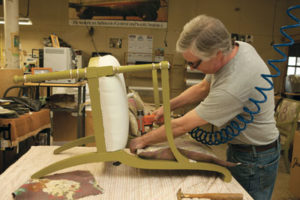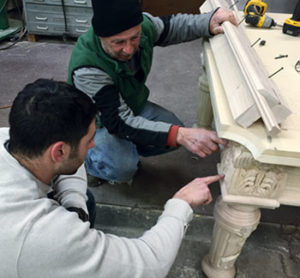Crafted by Hand
Writer Marirose KrallThink they don’t make furniture like that anymore? Think again.

The finished products are a graceful addition to this room by Greenbaum Interiors.
Nowadays, we’re used to shopping for finished products—prepared food, ready-to-wear clothing. And we’re so accustomed to choosing furniture from a showroom floor that it can be a bit of a culture shock to witness the making of a chair or table from scratch. It’s striking how the experience of the senses—the buzz of a saw, the scent of wood stain and, quite honestly, the sight of the mess that handwork creates—can offer a whole new perspective on the labor, expertise and artistry required to create a high-quality piece of furniture.
We spoke with several people who make it their business to create handmade pieces for the home. Susan Greenbaum is president of Paterson, New Jersey-based Greenbaum Interiors, which offers both manufacturer brands and custom-made pieces fabricated in-house. Jeff Roeder is head craftsman at Blatt Billiards, a pool table fabricator with locations in Manhattan and Wood-Ridge, NJ. Alberto Alvarez is president of Alvarez Furnishings in Paterson, NJ, which specializes in refinishing, restoration, upholstering and custom manufacturing. They discussed the ways in which this age-old art is still relevant today.
Why choose a process that may (but not always) take longer than mass production and may (but not always) be more expensive? The element that attracts many buyers to handmade products is the ability to get exactly what they want—a unique piece created just for them. The possibilities are endless, Alvarez says. “Anything a customer has in mind, we can make it.”
Greenbaum reports that clients come to her “when they’re looking for something different and can’t find it in the marketplace.” That’s a pretty exciting thought: walk into a shop, describe an idea and have that vision brought to life.

“People appreciate this workmanship,” Susan Greenbaum says regarding the process of handcrafting furniture.
For the less certain among us who haven’t quite pinned down our preferences, “there’s a happy medium,” Roeder says. That involves choosing a “standard” model and having the fabricators “tailor it to specific wants and needs, anything from type of wood to trim style.” Greenbaum describes a plethora of options involving “any kind of carving or detail a client would like. Then we discuss finishes—whether it’s a painted finish, a stain or a faux finish. You can do a light lacquer and get a whole new look or paint it purple and have it be funky,” she says with a laugh.

Custom seating from Alvarez Furnishings features an interesting back “pocket.”
It’s all about that kind of personalization, says Roeder, who’s been asked to incorporate elements with particular meaning, such as initials or symbols. Alvarez explains that newly made pieces can be designed to coordinate with existing furniture. “We can match a stain to something clients already have in their house.”
The process begins at a literal “drawing board” with sketches based on a client’s request. And the participation doesn’t end there. Clients can be involved throughout the fabrication process. Greenbaum explains, “Some of our clients like to come in during the stages of production in case they want to make a change.”
While some homeowners choose custom fabrication, many others want to refurbish much-loved heirlooms, says Alvarez, whose firm often handles restoration work. Roeder has had the same experience. “Fairly often, the pieces have sentimental value…A lot of people have their parents’ or their grandparents’ table. We can bring a table to its original glory. When we’re done, it’s ready for another 100 years.”

Bruce and Jeff Roeder examine a hand-carved billiard table.
And that, of course, is another draw of handcrafted items—these pieces are built to last. They’re painstakingly constructed by skilled artisans. The craftspeople Alvarez employs, for example, “have more than 40 years of experience” in this field. And Roeder points out, “it’s the same manufacturing process that was done over a century ago. That’s why the tables last so long; we’re not cutting any corners.”
These age-old skills are learned the way they’ve been learned for centuries. “All of our carpenters and cabinetmakers have some sort of background in general woodworking,” Roeder says. “We assign them to a mentor. It’s really passed down from one cabinetmaker to the next.” Apprenticeships like this are rare in this day and age. “People with skill like that, they’re hard to come by,” Roeder says. Which is why, Greenbaum notes, “People really appreciate this workmanship.”

At the client’s request, the completed table was swathed with goldleaf and finished in high-gloss black. “It’s a pretty outrageous table,” Jeff Roeder of Blatt Billiards says.
That kind of workmanship takes a practiced eye. According to Roeder, “Cabinetmakers can look at the best parts of the grain and use the grain itself to bring about the best in the wood. They can use that wood and lay it on the table where it will look most beautiful. It really does become an art form.”
Indeed, this is art in its purest form—involving creative thought translated to a practical process, all taking place while standing knee-deep in sawdust. The bottom line, as Greenbaum puts it, is that these skilled craftspeople create furniture “the old fashioned way.”
